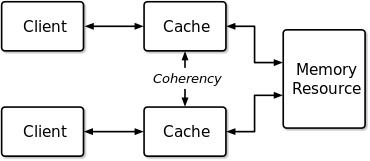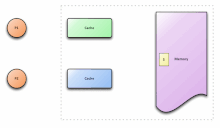
Back تنظيم الكاش في المعالجات التفرعية Arabic Coherència de la memòria cau Catalan Paměťová koherence Czech Cache-Kohärenz German Coherencia de caché Spanish انسجام حافظه نهان FA Välimuistin yhtenäisyys Finnish Protocole de cohérence de cache French Coerenza della cache Italian キャッシュコヒーレンシ Japanese


In computer architecture, cache coherence is the uniformity of shared resource data that is stored in multiple local caches. In a cache coherent system, if multiple clients have a cached copy of the same region of a shared memory resource, all copies are the same. Without cache coherence, a change made to the region by one client may not be seen by others, and errors can result when the data used by different clients is mismatched.[1]
A cache coherence protocol is used to maintain cache coherency. The two main types are snooping and directory-based protocols.
Cache coherence is of particular relevance in multiprocessing systems, where each CPU may have its own local cache of a shared memory resource.

- ^ Marowka, Ami (2010-01-01). "Chapter 2 - Pitfalls and Issues of Manycore Programming". Advances in Computers. Vol. 79. Elsevier. pp. 71–117. doi:10.1016/s0065-2458(10)79002-1.